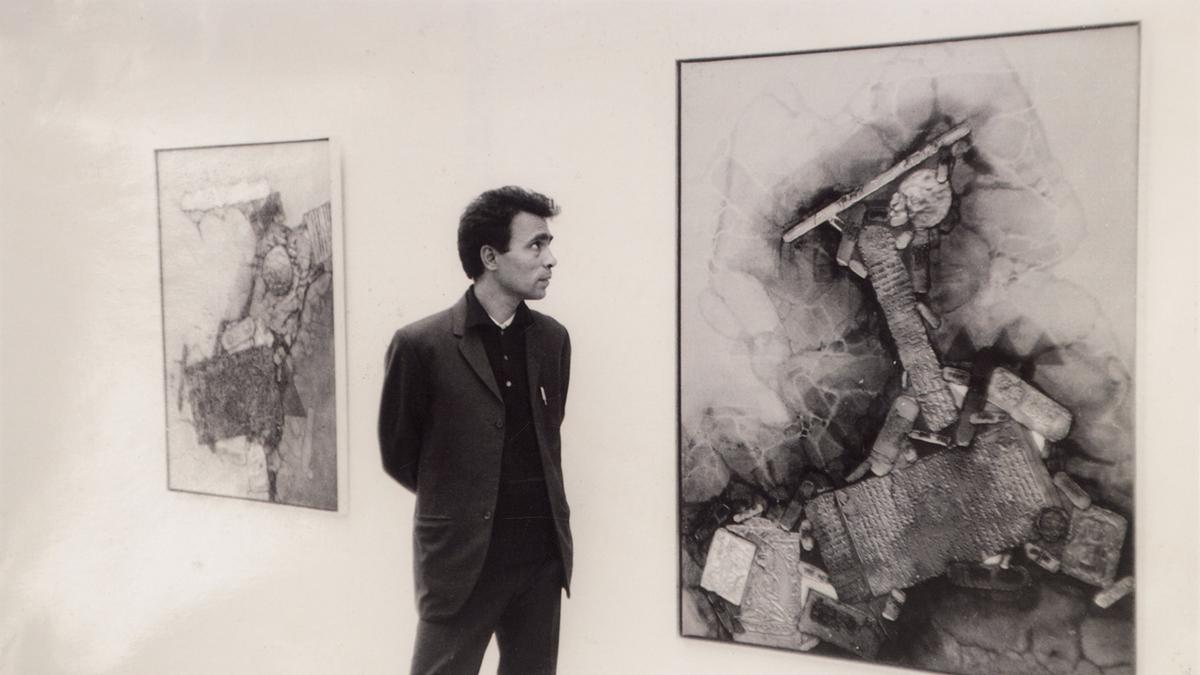
Where Shanti Dave belongs: India’s first calligraphic abstractionist is at DAG
The Hindu
India’s original calligraphic abstractionist, Shanti Dave, gets his first-ever retrospective, with DAG showcasing his work from 1950 to 2014
There was a time, in a newly independent India, when Shanti Dave’s name was inescapable in Indian art circles. Dave, among the country’s original Modern abstractionists, was one of the first batches to graduate under the great N.S. Bendre’s tutelage from the M.S. Baroda School of Fine Arts. Almost immediately, he had been invited to draw murals at the Rashtrapati Bhavan in Delhi. It was a tall honour and just the beginning.
Soon after the Lalit Kala Akademi was instituted in 1954, the artist from Badpura village in Gujarat won top prizes consecutively for three years, between 1956 and 1958. He flew around the world, representing India and being represented at international triennales. In the early 1960s, his reputation as a muralist began to transcend national borders. Commissions from Air India meant his art was decorating the walls of the airline’s Rome, Sydney, Bombay, London and New York offices. When The New York Times ran a large photo of the latter in print 1964, captioned ‘Little Gujarat’, Dave — now over 90-years-old — called it his life’s happiest experience.
Despite decades of unmatched fame and success, today his name is rarely invoked in the same breath as his contemporaries such as V.S. Gaitonde, Tyeb Mehta and M.F. Husain. How did a superstar of Indian modern art fall off the radar so completely?
Highlighting the legacy
“Some of that has to do with how the industry works,” says Jesal Thacker, curator of a new retrospective on Dave’s work, Neither Earth, Nor Sky at the Delhi Art Gallery (DAG). She has a keen interest in India’s lesser known modern abstractionists. “There was a time when only the very narrative or representational art was in vogue — by which I mean the work of M.F. Husain, Tyeb Mehta, F.N. Souza.” Today, however, it is the wealth of Modern abstraction and expressionism, from Ram Kumar to Gaitonde, that is driving international auctions. “Even V.S. Gaitonde has got his due and been recognised in the last 10 years or less,” she says. A 1979 untitled work of Gaitonde’s, for instance, sold for a whopping ₹20.5 crore at Christie’s first-ever India auction in 2013.
At the same time Dave, whose personality was “very withdrawn and inward-looking, sort of went into hiding”, adds Kishore Singh, head of exhibitions and publications at DAG. In the 1980s, the artist was drawn deeper into the Akademi’s administrative activities, he explains. “In the 1990s, Dave had a stroke, and following that he started making only very small works.”
When the markets opened up post-1991, Dave was nowhere on the scene. 1996 to 2008 was Indian contemporary art’s heyday and by the time the wealth of India’s modernist art began to be excavated, Singh says “there was already a wide gap between what Dave had done, his ongoing exhibitions and the people who remembered him”.





















 Run 3 Space | Play Space Running Game
Run 3 Space | Play Space Running Game Traffic Jam 3D | Online Racing Game
Traffic Jam 3D | Online Racing Game Duck Hunt | Play Old Classic Game
Duck Hunt | Play Old Classic Game











